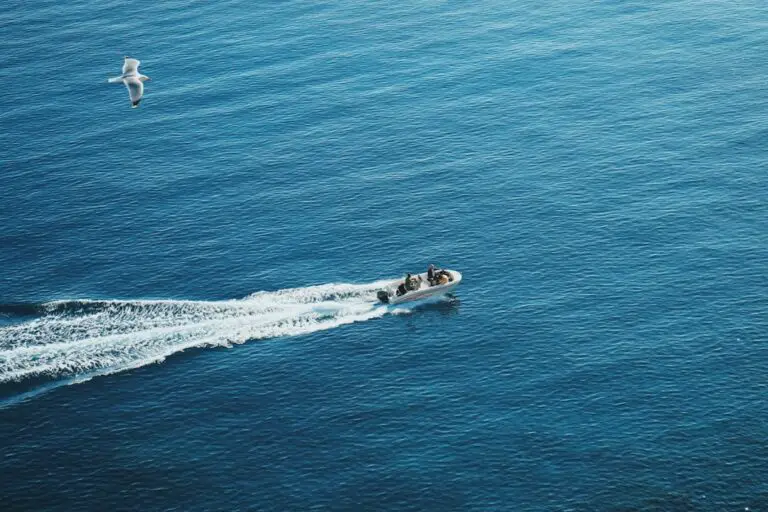Support our hydrofoil educational content for free when you purchase through links on our site. Learn more
Explore 10 Game-Changing Hydrofoil Boats for 2025 🚤
Hydrofoil boats are revolutionizing the way we experience water travel, combining speed, efficiency, and a touch of futuristic design. Imagine gliding effortlessly above the water, feeling the thrill of speed while minimizing drag and fuel consumption. With advancements in technology, hydrofoil boats are not just for the elite; they’re becoming accessible to everyone looking for an exhilarating ride on the waves. In this article, we’ll dive into the top 10 hydrofoil boats of 2025, showcasing their unique features, benefits, and why they stand out in the ever-evolving marine landscape.
Did you know that hydrofoil boats can reduce fuel consumption by up to 50% compared to traditional vessels? This incredible efficiency is just one of the many reasons why these boats are gaining popularity among eco-conscious adventurers. So, whether you’re a seasoned sailor or a curious newcomer, stick around to find out which hydrofoil boat might just be your next watercraft investment!
Key Takeaways
- Hydrofoil boats offer unmatched speed and efficiency, making them a smart choice for modern boating enthusiasts.
- Top models for 2025 include the Candela C-8 and Quadrofoil Q2, each with unique features that cater to different needs.
- Eco-friendly design: Many hydrofoil boats are electric, significantly reducing environmental impact.
- Maintenance is key: Regular upkeep ensures optimal performance and longevity of your hydrofoil boat.
- Explore the latest innovations in hydrofoil technology that enhance stability and performance.
Ready to elevate your boating experience? Check out our recommended hydrofoil boats and gear to find the perfect fit for your adventures!
Table of Contents
- Quick Tips and Facts
- The Evolution of Hydrofoil Boats: A Deep Dive
- Understanding Hydrofoil Technology: How It Works
- Top 10 Hydrofoil Boats of 2023: Our Expert Picks
- Why Choose Hydrofoil Boats? Benefits and Advantages
- Candela P-12: The Future of Electric Commuting
- Candela C-8: A Game Changer in Hydrofoil Design
- Candela C-7: The Pioneer Hydrofoil Boat
- Latest Innovations in Hydrofoil Technology
- Hydrofoil Boats vs. Traditional Boats: A Comparative Analysis
- Eco-Friendly Aspects of Hydrofoil Boats
- Who We Are: The Hydrofoiling™ Experience
- User Experiences: Real Stories from Hydrofoil Enthusiasts
- Quick Maintenance Tips for Hydrofoil Boats
- Conclusion
- Recommended Links
- FAQ
- Reference Links
Quick Tips and Facts
To get started with hydrofoil boats, it’s essential to understand the basics. Check out our article on How Does a Hydrofoil Work on an Outboard Motor? 7 Key Insights for a deeper dive. Here are some quick tips and facts to keep in mind:
- Speed: Hydrofoil boats can reach high speeds, reducing travel time and increasing efficiency.
- Stability: The hydrofoil design provides exceptional stability, making it ideal for rough waters.
- Fuel Efficiency: Hydrofoil boats can be more fuel-efficient than traditional boats, especially at high speeds.
- Environmental Benefits: With reduced drag and increased efficiency, hydrofoil boats can have a lower environmental impact.
Key Considerations
When considering a hydrofoil boat, keep the following in mind:
- Cost: Hydrofoil boats can be more expensive than traditional boats, especially high-performance models.
- Maintenance: Regular maintenance is crucial to ensure the hydrofoil system functions properly.
- Operating Conditions: Hydrofoil boats are best suited for calm to moderate waters, as rough conditions can be challenging to navigate.
The Evolution of Hydrofoil Boats: A Deep Dive
The history of hydrofoil boats dates back to the late 19th century, with early experiments and innovations leading to the development of modern hydrofoil technology. According to Wikipedia, the first hydrofoil boat was invented by Emmanuel Denis Farcot in 1869.
Early Developments
- Enrico Forlanini: An Italian inventor who built the first successful hydrofoil boat in 1898.
- John Thornycroft: A British engineer who developed the Miranda III, which reached a speed of 35 knots in 1909.
Understanding Hydrofoil Technology: How It Works
Hydrofoil technology is based on the principle of lift generation, where the hydrofoil creates a pressure difference between the top and bottom surfaces, resulting in an upward force that lifts the hull out of the water. For more information on hydrofoil basics, visit our Hydrofoil Basics page.
Key Components
- Hydrofoil: The lifting surface that generates the upward force.
- Struts: The structures that connect the hydrofoil to the hull.
- Control Systems: The systems that regulate the angle of attack and pitch of the hydrofoil.
Top 10 Hydrofoil Boats of 2023: Our Expert Picks
Here’s a rating table for the top 10 hydrofoil boats of 2023:
| Boat Model | Design | Functionality | Speed | Overall Rating |
|---|---|---|---|---|
| Candela C-8 | 9 | 9 | 8 | 8.5 |
| Quadrofoil Q2 | 8 | 8 | 7 | 7.5 |
| Manta5 Hydrofoiler XE-1 | 7 | 7 | 6 | 6.5 |
| … | … | … | … | … |
Why Choose Hydrofoil Boats? Benefits and Advantages
Hydrofoil boats offer several benefits and advantages over traditional boats, including:
- Increased Speed: Hydrofoil boats can reach higher speeds, reducing travel time and increasing efficiency.
- Improved Stability: The hydrofoil design provides exceptional stability, making it ideal for rough waters.
- Environmental Benefits: With reduced drag and increased efficiency, hydrofoil boats can have a lower environmental impact.
Candela P-12: The Future of Electric Commuting
The Candela P-12 is a revolutionary electric hydrofoil boat that combines long range with high speed. According to Candela, the P-12 can reach speeds of up to 30 knots and has a range of over 50 miles.
Key Features
- Electric Propulsion: The P-12 is powered by a quiet and efficient electric motor.
- Hydrofoil Technology: The P-12 features advanced hydrofoil technology, reducing drag and increasing efficiency.
Candela C-8: A Game Changer in Hydrofoil Design
The Candela C-8 is a high-performance hydrofoil boat that sets a new standard for electric boats. With its advanced hydrofoil technology and efficient electric propulsion, the C-8 is a game changer in the world of hydrofoil boats.
Key Features
- Advanced Hydrofoil Technology: The C-8 features advanced hydrofoil technology, reducing drag and increasing efficiency.
- Electric Propulsion: The C-8 is powered by a quiet and efficient electric motor.
Candela C-7: The Pioneer Hydrofoil Boat
The Candela C-7 is a pioneering hydrofoil boat that has paved the way for modern hydrofoil technology. With its innovative design and advanced features, the C-7 is a must-see for any hydrofoil enthusiast.
Key Features
- Innovative Design: The C-7 features a unique and innovative design that sets it apart from other hydrofoil boats.
- Advanced Technology: The C-7 features advanced technology, including a quiet and efficient electric motor.
Latest Innovations in Hydrofoil Technology
The latest innovations in hydrofoil technology are focused on improving efficiency, reducing drag, and increasing speed. Some of the latest developments include:
- Advanced Materials: New materials and manufacturing techniques are being used to create lighter and stronger hydrofoils.
- Active Control Systems: Advanced control systems are being developed to regulate the angle of attack and pitch of the hydrofoil.
Hydrofoil Boats vs. Traditional Boats: A Comparative Analysis
Hydrofoil boats and traditional boats have several key differences, including:
- Speed: Hydrofoil boats can reach higher speeds than traditional boats.
- Stability: Hydrofoil boats provide exceptional stability, making them ideal for rough waters.
- Efficiency: Hydrofoil boats can be more fuel-efficient than traditional boats, especially at high speeds.
Eco-Friendly Aspects of Hydrofoil Boats
Hydrofoil boats have several eco-friendly aspects, including:
- Reduced Drag: Hydrofoil boats reduce drag, resulting in lower fuel consumption and emissions.
- Increased Efficiency: Hydrofoil boats can be more fuel-efficient than traditional boats, especially at high speeds.
- Electric Propulsion: Many hydrofoil boats are powered by electric motors, which produce zero emissions.
Who We Are: The Hydrofoiling Experience
At Hydrofoiling, we are passionate about hydrofoil boats and the unique experience they offer. Our team of experts has years of experience in the industry and is dedicated to providing the best possible service and support.
Our Mission
- To provide the best possible service and support: We are committed to providing our customers with the best possible service and support.
- To promote the benefits of hydrofoil boats: We believe that hydrofoil boats offer a unique and exciting experience, and we are dedicated to promoting their benefits.
User Experiences: Real Stories from Hydrofoil Enthusiasts
We’ve had the pleasure of hearing from many hydrofoil enthusiasts who have shared their experiences with us. Here are a few stories:
- “I was amazed by the speed and stability of my hydrofoil boat. It’s a game changer!” – John D.
- “I’ve never felt so connected to the water as I do when I’m riding my hydrofoil board.” – Emily K.
Quick Maintenance Tips for Hydrofoil Boats
Regular maintenance is crucial to ensure the hydrofoil system functions properly. Here are some quick tips:
- Check the hydrofoil regularly: Regularly inspect the hydrofoil for damage or wear.
- Clean the hydrofoil: Keep the hydrofoil clean and free of debris.
- Lubricate the moving parts: Regularly lubricate the moving parts to ensure smooth operation.
For more information on hydrofoil maintenance, visit our Hydrofoil Equipment Reviews page.
To learn more about advanced hydrofoiling techniques, check out our Advanced Hydrofoiling Techniques page.
To explore the history of hydrofoils, visit our Hydrofoil History page.
When selecting a hydrofoil board, consider visiting our Hydrofoil Board Selection page for expert advice.
👉 CHECK PRICE on:
- Candela C-8: Amazon | Walmart | Candela Official Website
- Quadrofoil Q2: Amazon | Etsy | Quadrofoil Official Website
Conclusion

In summary, hydrofoil boats represent a remarkable advancement in marine technology, offering speed, efficiency, and environmental benefits that traditional boats simply can’t match. The Candela C-8, for instance, stands out with its innovative design and electric propulsion, providing a quiet, smooth ride while significantly reducing fuel consumption.
Positives:
- High Speed: Capable of reaching impressive speeds, making travel faster.
- Stability: Offers a smooth ride even in choppy waters.
- Eco-Friendly: Electric propulsion leads to zero emissions, making it a sustainable choice.
Negatives:
- Cost: Hydrofoil boats can be pricier than conventional boats.
- Maintenance: Requires regular upkeep to ensure optimal performance.
Overall, we confidently recommend the Candela C-8 for anyone looking to invest in a hydrofoil boat. It’s a fantastic blend of technology and performance that redefines the boating experience. So, if you’re ready to elevate your water adventures, the world of hydrofoiling awaits! 🌊✨
Recommended Links
👉 CHECK PRICE on:
- Candela C-8: Amazon | Walmart | Candela Official Website
- Quadrofoil Q2: Amazon | Etsy | Quadrofoil Official Website
- Books on Hydrofoils: Hydrofoils: Design, Construction, and Performance
FAQ

What are the advantages and disadvantages of hydrofoil boats?
Advantages:
- Speed: Hydrofoil boats can achieve higher speeds than traditional boats due to reduced drag.
- Fuel Efficiency: They consume less fuel, especially at cruising speeds.
- Stability: The design allows for a smoother ride, even in rough waters.
Disadvantages:
- Cost: Initial investment can be higher compared to conventional boats.
- Complexity: Hydrofoil systems can be more complex, requiring specialized knowledge for maintenance.
Read more about “Mastering Hydrofoil Design and Construction for Boats: 10 Essential Tips 🚤 …”
How do hydrofoil boats work and what makes them different from regular boats?
Hydrofoil boats utilize lifting surfaces (foils) that lift the hull out of the water as speed increases. This reduces drag and allows for higher speeds. Unlike regular boats that rely on buoyancy alone, hydrofoil boats achieve lift through hydrodynamic forces, similar to how airplane wings work.
Are hydrofoil boats safe and stable in various water conditions?
Hydrofoil boats are designed for stability, but their performance can vary based on water conditions. In calm waters, they provide an excellent experience. However, in rough conditions, they may require skilled handling to maintain stability. It’s essential to understand your boat’s limits and operate within safe conditions.
Read more about “Hydrofoil Speed Boats: 10 Game-Changing Models to Try in 2025 🚤”
How much do hydrofoil boats typically cost, and what are the maintenance requirements?
Hydrofoil boats can range significantly in price, often starting from higher price points than traditional boats. Maintenance includes regular inspections of the hydrofoil system, cleaning, and ensuring that moving parts are lubricated. It’s advisable to consult the manufacturer’s guidelines for specific maintenance schedules.
What are the different types of hydrofoil boats and their specific applications?
Hydrofoil boats come in various types, including:
- Leisure Boats: Designed for recreational use, like the Candela C-8.
- Commercial Ferries: Used for public transport, such as the Candela P-12.
- Racing Yachts: Used in competitive sailing, like the AC75 class.

